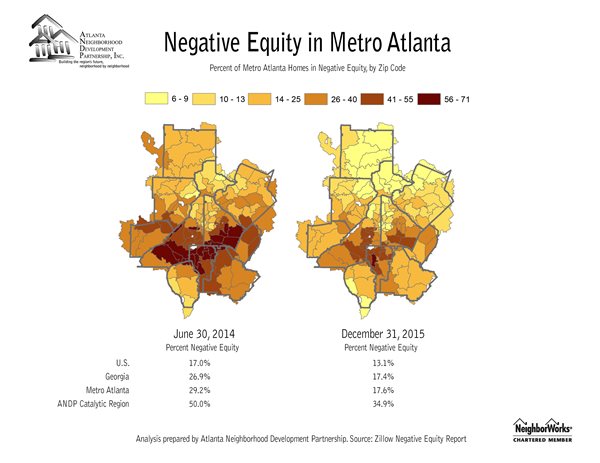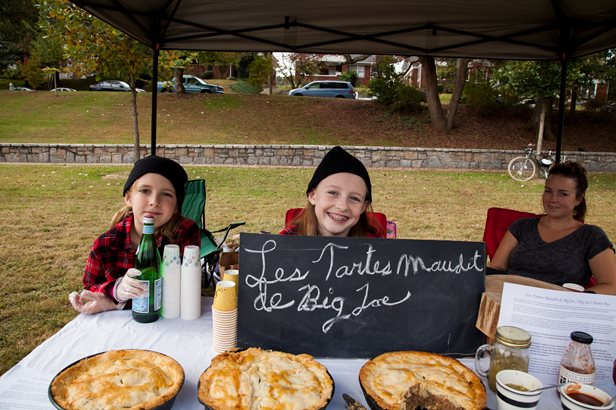 |
| Community engagement is central to the success of revitalization. |
Much of the media and policy conversations have moved past the housing crisis that swept the country like a tsunami eight years ago. Nationally, RealtyTrac reports that in April, the number of properties that received a foreclosure filing was 7 percent lower than the previous month and 20 percent lower than the same time last year.
However, the story isn’t so rosy everywhere. As the Columbia Journalism Review noted, “there’s plenty of this story left to tell—and progress in our cities will depend, in part, on the strength and depth of the coverage we give it. When it comes to creating a climate where positive change can happen, there needs to be a certain level of dialogue among the public about cities as places of value.”
One of the flashpoints for this ongoing discussion is metropolitan Atlanta, home of the Atlanta Neighborhood Development Partnership (ANDP), a recipient of a NeighborWorks America Catalytic Grant. The grant program is designed to “strengthen local capacity to plan and implement comprehensive approaches to community stabilization that produce measurable gains.” The challenge ANDP chose to address with its Catalytic Grant is the high number of underwater homes in the counties it serves, and the need to increase home values and stimulate market activity. [A home is considered underwater (having negative equity) if the owner owes more for the house than it is currently worth on the market.]
“The sheer number of foreclosures has declined, yes,” says George Burgan, ANDP’s director of communications. “But the new challenge is in the aftermath: neighborhoods with high levels of underwater homeowners.”
At the end of 2013, 36 percent of Atlanta homeowners were still underwater on their mortgages, tieing it with Los Angeles as the hardest-hit city among the top 14 major metropolitan areas. In that year, Atlanta home prices remained 27 percent below their peak levels, according to the Haas Institute. These conditions were and continue to be particularly apparent in majority-black neighborhoods. As documented in The Washington Post in April, “throughout the South and in metropolitan Atlanta in particular, places with lingering negative equity are in predominantly black zip codes. When recent research was controlled for income levels and housing quality, race still mattered. When controlled for the severity of the earlier subprime and foreclosure crises, race still mattered. When controlled for how far prices tumbled during the bust, race mattered even more.”
The Catalytic Grant, says Burgan, has allowed ANDP to focus its efforts at a scale that is having an impact, albeit gradually. ANDP’s goals are ambitious: to “transform the cradle of communities we’re serving into a collection of thriving neighborhoods where residents can access sustainable homeownership options, nonprofits and businesses are connected to critical development capital, resident leaders have the resources they need to restore neighborhoods, and local governments benefit from a stronger tax base.”

Nearly a year after receiving the grant, Burgan describes the results to date as significant, but with still a long way to go in some areas. When ANDP first started tracking negative equity, some counties were as high as 70 percent underwater. Today, the percentage in the worst of the areas, Clayton County (just south of the busiest airport in the world), is 47—much better, but still high. (Keep in the mind that the national average is 13 percent; in Georgia as a whole, it’s 18.3.)
So what is making a difference, and what lessons has ANDP learned?
Educate and engage homeowners
“A lot of homeowners are not aware of federal, state and other programs and services that can help them—for example, through mortgage-loan modification,” notes Burgan. “We have to continue to hammer that message home.”Last fall, ANDP sent a team of resident leaders to NeighborWorks America’s Community Leadership Institute (CLI). The team returned home inspired to hold their own, mini CLI in Atlanta to get more residents involved in developing solutions. They conducted an extensive survey of their respective neighborhoods and found that the top three priorities were improving public safety by addressing crime associated with vacant, blighted properties; cultivating better perceptions of the communities to attract new residents and businesses; and fostering more inclusiveness to bridge the growing divide between homeowners and renters. The event, called Neighbors Together, will be held during this year’s NeighborWorks Week and offer coaching and training related to these issues.
 |
| ANDP offers training on topics such as neighborhood branding. Residents are encouraged to create a signature neighborhood event, like this Porches and Pies fest in Atlanta’s Adair Park community. |
“The CLI team came from a broad area in metro Atlanta,” says Mary Wilson, a long-time community leader who was among the group. “But there was one common denominator: the need to develop more resident leaders.”
Bring stakeholders to the table
Last year, ANDP shifted the focus of its foreclosure-response initiative, called Piece by Piece, to addressing negative equity in the region. A symposium called "Underwater Atlanta" one of ANDP's Catalytic Grant achievement milestones, brought local, state and federal stakeholders together to discuss strategies for increasing participation in mortgage-modfication programs and efforts to strengthen home values.Founded in 2010, Piece by Piece brings together and coordinates players such as the Atlanta Regional Commission, Enterprise Community Partners, Federal Reserve Bank of Atlanta, Greater Atlanta Home Builders Association and The Home Depot Foundation. Their goals are to monitor the status of metro Atlanta’s foreclosure crisis, identify opportunities for coordination and best-practice sharing, and encourage public commitments to goals and actions. One of their joint initiatives was the production of a comprehensive resource guide.
“The key is to get as many players to the table as you can,” says Burgan. “Don’t leave any audiences out. Vacant homes attract crime, which spreads like cancer. So they will want to work with you.”
Think big; don’t be afraid to be ambitious
ANDP and its collaborators didn’t restrain its strategies to local players. They also successfully lobbied the Federal Housing Finance Agency (FHFA) to include metro Atlanta in the Neighborhood Stabilization Initiative, initially piloted in Chicago and Detroit. The program, which offers mortgage principal reductions to some underwater homeowners, now is offered in 18 metro areas, including Atlanta. It provides nonprofits like ANDP with first opportunity to purchase foreclosed homes held by Fannie Mae and Freddie Mac.Locally, ANDP and several coalition members also have effectively advocated for an ordinance under which developers building multi-family homes in the city and that receive public funds will have to set aside up to 15 percent of their units for individuals who make 80 percent of the area median income or 10 percent for lower-income residents (those who make 60 percent of the AMI).
In addition, rent for the new units will be capped at 30 percent of tenants’ monthly gross income. If a developer doesn’t comply, the city will refuse to issue a certificate of occupancy. The affordable housing units must also be similar in construction and appearance to the rest of the building. The ordinance will go into effect in July.
Generate attention in the media
“People are tired of hearing about foreclosures,” noted Burgan. “But the crisis isn’t over and it is important that policymakers and other stakeholders understand that.”That’s where the media come in. To date, ANDP has been successful in generating significant local media coverage of the metro’s challenges, as well as bytwo national publications, The Wall Street Journal and The Washington Post. Both reporters visited Atlanta personally, spending time with ANDP CEO John O'Callaghan and other housing advocates.
“It’s all about keeping the issue in the forefront of the minds of people who set policy and make community development decisions,” says Burgan. “That’s why we also send an e-blast once or twice a month to more than 1,000 selected stakeholders. These and other efforts will continue long past the Catalytic Grant ends. We’ve got real momentum going now.”

